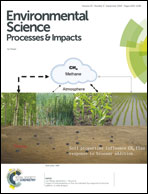Lead and zinc concentrations in household dust and toenails of the residents (Estarreja, Portugal): a source-pathway-fate model†
Abstract
This paper describes a methodology developed to assess and apportion probable indoor and outdoor sources of potentially toxic elements while identifying chemical signatures in the household dust collected from private homes in an industrial city (Estarreja, central Portugal). Oral bioaccessibility estimates and the chemical composition of toenail clippings were used to assess indoor dust ingestion as a potential exposure pathway and further investigate exposure–biomarker relationships. Indoor and paired outdoor dust samples were collected from each household. A total of 30 individuals, who provided toenail clippings and a self-reported questionnaire, were recruited for the study. Total concentrations of 34 elements, including lead and zinc, were determined in washed toenail samples and household dust via Inductively Coupled Plasma-Mass Spectrometry. The oral bioaccessibility was estimated using the Unified BARGE Method. The enrichment factor shows that lead was enriched (10 < EF < 100) while zinc (EF > 100) was anomalously enriched in the household dust, thus indicating potential exposure in the home environment. The results from principal component analysis coupled to cluster analysis and linear discriminant analysis suggested that mixed contamination derived from multiple sources with a predominance of biomass burning. Stepwise multiple linear regression analysis was performed to model toenail data using the indoor dust elemental composition. Whereas the model obtained for lead was not reliable, indoor dust zinc and antimony contents arose as good predictors of toenail zinc. The exposure–biomarker relationships seem to be influenced by the oral bioaccessibility of the elements.



 Please wait while we load your content...
Please wait while we load your content...